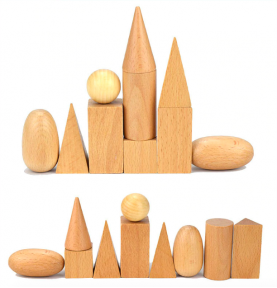Montessori wooden geometric shapes bag
This sensory bag of wooden shapes is a material used in Montessori pedagogy to be used from 2 and a half years old in order to develop the learning of shapes and volumes as well as the dexterity of the child.
Bag color: White.
These bags are initially packaged in a display of 12 pieces. We sell individually, so it is possible that it will be sent without the packaging.
Montessori method
These wooden solids are tools that can be used in Montessori pedagogy. It will delight children from 2 and a half years old. Please note that they are to be used under the supervision of an adult.
The Montessori method was created by Maria Montessori, an Italian doctor and educator in 1907. Today it is used in more than 22,000 establishments around the world. The particularity of the Montessori method is to highlight the personal development of the child and to encourage his autonomy through educational toys based on the senses and perception.
Montessori learning
These geometric solids will develop your child's cognition by mobilizing learning the basics of geometry by discovering the different shapes (and their names) as well as volumes.
Children will be able to more easily diagram the concepts of geometry in space and make the link between the 2nd dimension and the 3rd dimension. They will be able to recognize the different solids found in their daily lives.
It will also be possible to show the child the usefulness of geometry through constructions.
Depending on the age of the child, these wooden solids can be used in different ways. In any case, it is important to always verbalize the objective, for example "We will recognize solids only with the hands".
- Shape spotting: Simply put the solids in flour, plasticine or magic sand in order to leave the imprint of a shape and have the child identify the shapes thus obtained.
- Visual association: Place the solid shapes on a sheet showing the solids in 3D then a sheet showing the different shapes shown in 2D and vice versa.
- Association by touch:
Variant 1 (Need 2 lots of solids for this variant): The child puts their hand in the bag provided containing the first batch of solids and takes a solid there, then they must associate it with the corresponding solid of the second batch on the table.
Variant 2 for two to three children: Two children each have their hands in their respective bags containing the solids and the third child names the name of a solid (if he knows the name solids) or he shows it and the others have to look for it in their bag (without the view) or they have to associate it with the solid shown in 2D or 3D on a sheet. - Knowing how to name shapes: The child names the shape you are showing by learning effect and then, conversely, he identifies the shape you name.
Variant: Association by touching by naming: the adult names a solid by its name and the child must find it only by touching the solids hidden in the bag provided. Then you can switch roles. - Association by reading: When the child can read, he can alone associate the shape of the solid with the name of the figure noted on a sheet.
Motor skills & Perception in space
These wooden shapes will develop your child's motor skills because he will have to make the connection between the movement of his hands and the coordination of his eyes, which will develop his abilities.
In addition, this toy will allow children to increase their spatial perception.
Benefits
These toys can be taken anywhere with you thanks to their pocket size.
This toy is inspired by the Montessori method thanks to its playful and fun side, it is not a Montessori toy.
Data sheet
- Weight
- 100 g
- Âge
- 3+
Specific References
3 other products in the same category:
-
Gift option£2.99
-
Montessori Wooden Rainbow +...£94.99 -5% £90.24















